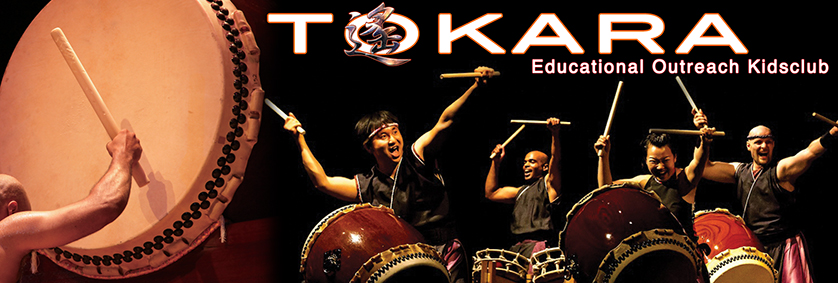About Taiko
Taiko (also called Wadaiko in Japan, literally meaning “Large Japanese Drum”) is a combination of percussion,
dance and martial arts mixed with power, speed and syncronous movement...resulting in an awe-inspiring experience.
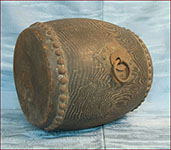 Between seven and ten thousand years ago, in the Jomon Period, simple taiko beats would be used to signal that the village hunters were setting
out to gather food, or to signal that a storm was coming and everyone should find shelter. The taiko drums were used as a way of calling out to the
whole village at one time to relay certain messages or to call a village meeting. This was used as a simplistic variation of village and town loudspeaker
announcements which take place in many parts of modern Japan. The taiko were also used as a means to pray for rain and for a successful harvest,
as well as to strike fear into an enemy before battle. Since that time, taiko has been a deeply rooted aspect of Japanese history and culture.
The rumbling power of the taiko has also long been associated with the gods, and has been appropriated by the philosophical beliefs and Shinto religion of Japan. Between seven and ten thousand years ago, in the Jomon Period, simple taiko beats would be used to signal that the village hunters were setting
out to gather food, or to signal that a storm was coming and everyone should find shelter. The taiko drums were used as a way of calling out to the
whole village at one time to relay certain messages or to call a village meeting. This was used as a simplistic variation of village and town loudspeaker
announcements which take place in many parts of modern Japan. The taiko were also used as a means to pray for rain and for a successful harvest,
as well as to strike fear into an enemy before battle. Since that time, taiko has been a deeply rooted aspect of Japanese history and culture.
The rumbling power of the taiko has also long been associated with the gods, and has been appropriated by the philosophical beliefs and Shinto religion of Japan.
In the modern era, taiko drumming was revolutionized and made popular by Grandmaster Daihachi Oguchi, who is noted as the person who created
the original performance art of taiko drumming when he established his own performance group in 1951. The dynamic style that he created eventually
grew to incorporate the three distinct components of percussion, martial arts and dance, which are interwoven with kakegoe (voice), kata (form) and
waza (technique) to create a highly sophisticated form of solo and ensemble performance. After forming his performance group, Grandmaster Oguchi travelled extensively to
teach many the art of kumi-daiko (ensemble drumming).
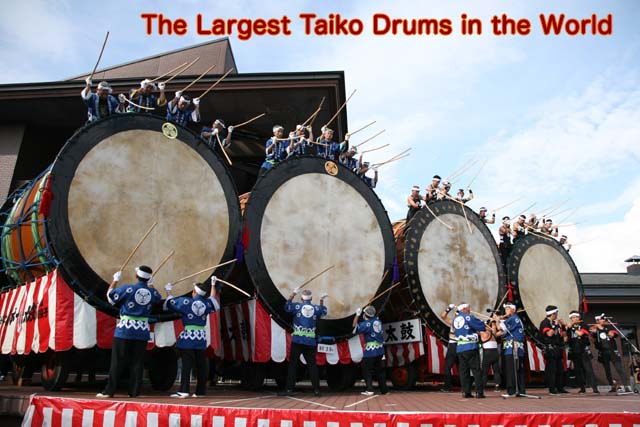 Although Art Lee had previously studied the Osuwa Daiko style of taiko, he began extra study with Grandmaster Daihachi Oguchi shortly after moving to Japan in 1998.
Art Lee was greatly honored in 1999 when Grandmaster Daihachi Oguchi invited him to join Osuwa Daiko, and then the newly-formed, internationally touring group Ashura-gumi in 2002. Although Art Lee had previously studied the Osuwa Daiko style of taiko, he began extra study with Grandmaster Daihachi Oguchi shortly after moving to Japan in 1998.
Art Lee was greatly honored in 1999 when Grandmaster Daihachi Oguchi invited him to join Osuwa Daiko, and then the newly-formed, internationally touring group Ashura-gumi in 2002.
Apprentice to and Performers of Wadaiko Ensemble Tokara are all taught the traditional style of taiko, including the Osuwa Daiko style. Extensive training in these traditional
styles as apprentices is a prerequisite to begin training in the unique Tokara style.
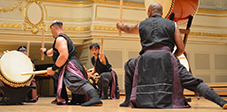 Miyake Daiko Miyake Daiko
**Traditional/arranged by Art Lee**
Around the island of Miyake, just off the coast of Tokyo,
the ocean caresses, slowly and smoothly, the outstretched land.
As the waters move away from the island, they begin to move
rapidly and gain strength as the wind and the ocean floor pushes
the waters upward and on, more powerfully until reaching the
mainland with full force.
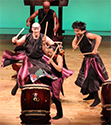 Buchiawase Daiko Buchiawase Daiko
**Traditional**
In the south of Tokyo on the Miura Peninsula, "Buchiawase"
is played after a successful round of fishing. There is a contest. One Taiko-group plays the piece on the mountain in Minsaki,
the other group on the opposite mountain.
"Buchiawase" is usually played so powerfully and aggressively
that it is also called "Kenka Daiko", which means "The
Fighting Drums"
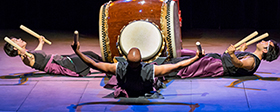 Chichibu Yatai Bayashi Chichibu Yatai Bayashi
**Traditional/arranged by Art Lee**
Originating in Chichibu, Saitama Prefecture, this
piece is played in a sitting position, simulating the posture needed
during various festivals in Japan. The player sits inside a small and
intricately carved float which is pulled and pushed very quickly by
nearly one hundred people. Depending upon the rhythms played, everyone
will know whether to turn left or right or to stop.
 Hatou no Hibiki Hatou no Hibiki
**Written by Art Lee**
Who doesn't enjoy walking up and down the beach, listening
to the ocean and the birds, and that cute dog who just knocked you
over trying to get to his frisbee?
At the bottom of the beach, we can see the
Hatou where the water turns white as it's kicked up by sand and rock.
The name signifies the beauty and calm of the lapping waves, but the
piece itself takes you to a party...the one you can hear and see just
beneath those lapping waves as the rocks and sand bump each other.
|
